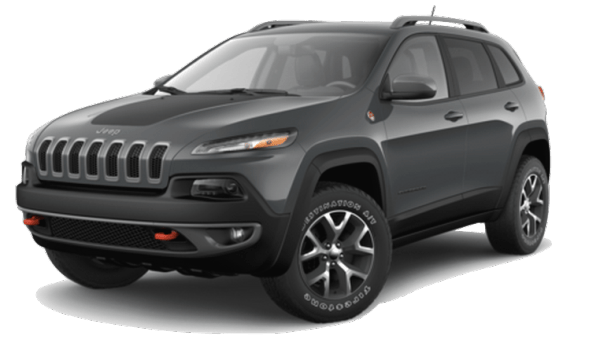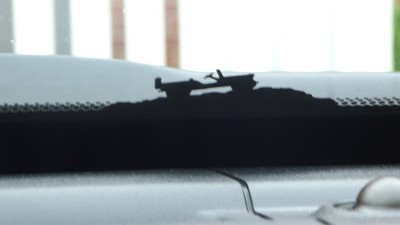2014 Jeep Cherokee Trailhawk: Tough But Lovable

I love Jeep. Will I Love the Jeep Cherokee Trailhawk’s New Look Just as Much?
Here’s what I love about Jeep: it’s rugged on the outside and rugged on the inside. That’s because with two kids we need a car that can handle the insults to its interior just as much as the insults the road throws it.
But the Jeep Cherokee Trailhawk—more on what that means in a minute— that we recently took on a five day test drive was not only rugged, it was luxurious, too. On our road trip, we put it through all the Reiss family tests: long drive, short trips, luggage, hauling, snacking, device charging and more as we made our way to Detroit from Connecticut.
Here’s my first disclosure: I am a fan of Jeep. We owned two and drove both more than 150,000 miles. But then we needed a third row and we had to trade it in.
So when we saw the 2014 Jeep Cherokee Trailhawk in our driveway, we were excited but also, curious. Jeep’s new design has a flair that is un-Jeep: its nose is angled, its lines are softer and its colors are a departure from the military-inspired camo-palette of the past. Would we like this as much as we had our ’95 and ’99 Jeeps?
Once inside, the answer was absolutely, yes.
Beneath The Redesigned Exterior, This Car is All Jeep.
Even though the Cherokee’s front end didn’t look familiar, getting into the cabin was like greeting an old pal. We had always loved the super comfortable seats in our Jeeps, the way they cradle you and hold you steady, but are so comfortable you can ride in them for hours.
Hands on the steering wheel, I shifted the car into gear and it was like being behind the wheel of my old Grand Cherokee. The wheel felt solid in my hands and I felt in command of the car and the road. But I also love the modernized feeling of the cabin, including more comfortable rear seats (our old Cherokee’s back seat was a bit stiff, but with kids in car seats, we got no complaints); rugged floor mats that made cleaning out the back seat a breeze; and climate control for back seat passengers.

The Cherokee is filled with nice little touches, like this net on the passenger side of the center console, perfect for holding my phone and EZPass.
UConnect: Media and Navigation Smartly Designed.
Among my favorite modern touches, though, is the media console. Chrysler’s UConnect system has a very nicely thought-out navigation and entertainment system—one of the best I’ve seen. The navigation screen clearly shows you where you’re going, names of locations on the map and—YES!—the speed limit of the road you’re on. The screen and graphics are big enough so you can see at a glance where you are, and having a short “glance time” is key; you don’t want to take your eyes off the road for very long.
UConnect also has a very nice layout for entertainment choices. You can easily surf between preset stations or cruise radio or satellite options to find your next choice. Again, selections and information are displayed big and simple at the top of the screen so you can easily see what station you’re on. And best of all, most (all?) commands can be made from buttons on the back of the steering wheel, another nice feature (and one Chrysler was first in the market with).
At the bottom of the screen are simply arranged icons to control climate, seat temperature, phone and more. Among the options are Apps, and another big YES: wifi. Ahhhh… the luxury of modern conveniences!

The UConnect Navigation screen is easy to read and includes a key factor: the speed limit of the road you’re on.
A Must-Have On the Cherokee—Or Any New Car, For That Matter.
Probably my favorite feature, though, was the Cherokee’s safety technology package: blind spot detectors, a rear view camera and adaptive cruise control. These features make driving a long distance stress-free, and backing in and around parking lots much easier. The park assist helps too, but we didn’t use that feature; the rear view camera did the trick for us. After using a rear view camera, I can’t imagine life before it.
During the long drive from Connecticut to Detroit the adaptive cruise came in quite handy: you set it and it adjusts the car’s speed to slowing and stopping of traffic, leaving you to relax behind the wheel. On a long trip, having adaptive cruise truly takes the stress out of the trip.
My First Time Doing This In A Jeep—Bet You’ve Never Done This Either.
It was sort of a joke all those years that we had Jeeps and never once went off road, but it’s typical: most SUV owners never take the vehicle off road. But the reason we had the Jeep was for the off-road type challenges a city can offer, like potholes the size of ostriches and the ability to see over dead-stopped traffic. And if you’ve ever decided to pull up over a curb so you can park in an over-crowded school parking lot or on the wet, muddy grass at church on Easter (you know, when everyone goes and the church is way over-subscribed) and you’re like me and you never get there early for a good parking spot—well, that’s when you appreciate Jeep the most: you can conquer any curb or mud pit for good parking.
So What is “Trail Rated” Anyway?
The chance to get behind the wheel on an off-road course was an eye-opener. I was never that interested in off-roading because while it looked fun, that’s a lot of bumping and jiggling in the passenger seat; not so much fun. I was able to drive on a course with a Jeep expert who took me through knee-deep water, over a pile of rocks, up a flight of stairs and through a mud pit, and there was not nearly as much jiggling as I’d thought.
The Jeep was trail rated: Jeep’s own designation that it can drive with one or two wheels off the ground, that it has ‘skid plates’ that protect the underside of the car from rocks or other things that might damage it, that it can drive through deep(ish) water, and that it’s capable and commanding in all conditions. My one last concern is that you want to know what is on the other side of the rocks, but Jeep and its experts seem confident that whatever might lurk, Jeep can handle it.
Sparking Conversation At The Valet.
When we arrived at the Westin Book Cadillac in downtown Detroit, we pulled into the valet to park the car and check in. The valet captain and a few other staffers came to welcome us, but also, they wanted to know about the Cherokee; they’d been curious about the newly designed Jeep and wanted to check it out. Their sentiment wasn’t unusual; a lot of consumers have been looking over the new Jeeps and buying them; Jeeps sales so far this year are way up—50% for the first half of the year. It’s nice to see a car brand that I’ve loved so much do so well in its reincarnation.
What We Loved
- All Jeep, all the time; a classic reinvented with its integrity and heritage intact
- Comfortable seats
- Leather interior
- 21 MPG City. Wow. Just wow. (27MPG highway)
- Safety tech package with adaptive cruise, rear view camera and blind spot detectors (this is an option)
- UConnect—much improved over previous versions and filled with great options
- Drive type dial—Auto, Snow, Sport, Mud, Rocks—is standard equipment, as is hill hold and descent assist
- ‘Smart’ windshield wipers—sense the rain and automatically wipe the windshield
- 5 Year/100 mile roadside assistance
- Passive entry ‘smart’ key (part of a premium package)
What You Need to Know
- Model we tested didn’t have a sunroof, an option I would definitely choose
- USB ports and power chargers are all up front and in the center console, with one in rear hatch
- 2.4L engine was capable but not overly powerful. Hence the gas mileage.
- Comes with a spare tire. It’s a Jeep.
- 3 year/3,000 mile warranty (5 year/100K mile power train warranty)
- Trail rated and ready for off-road action
- Base price: $29,495; price of the model we tested: $37,215
Disclosure: Jeep provided the Cherokee Trailhawk for our test drive; opinions expressed here are all my own.



